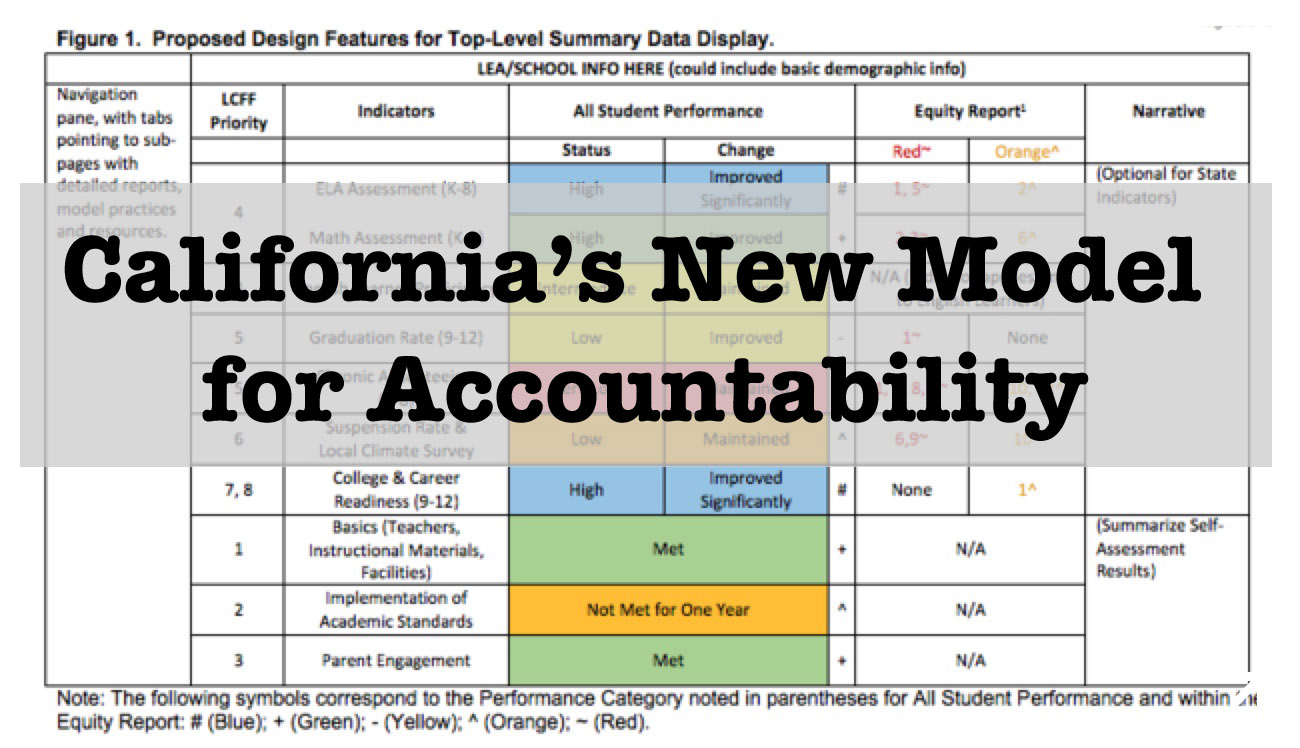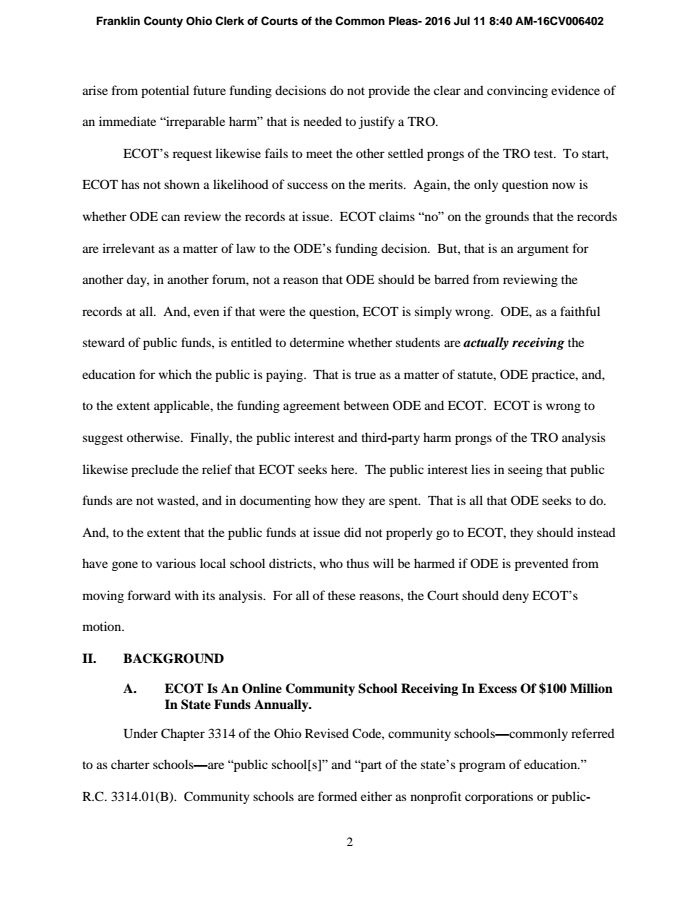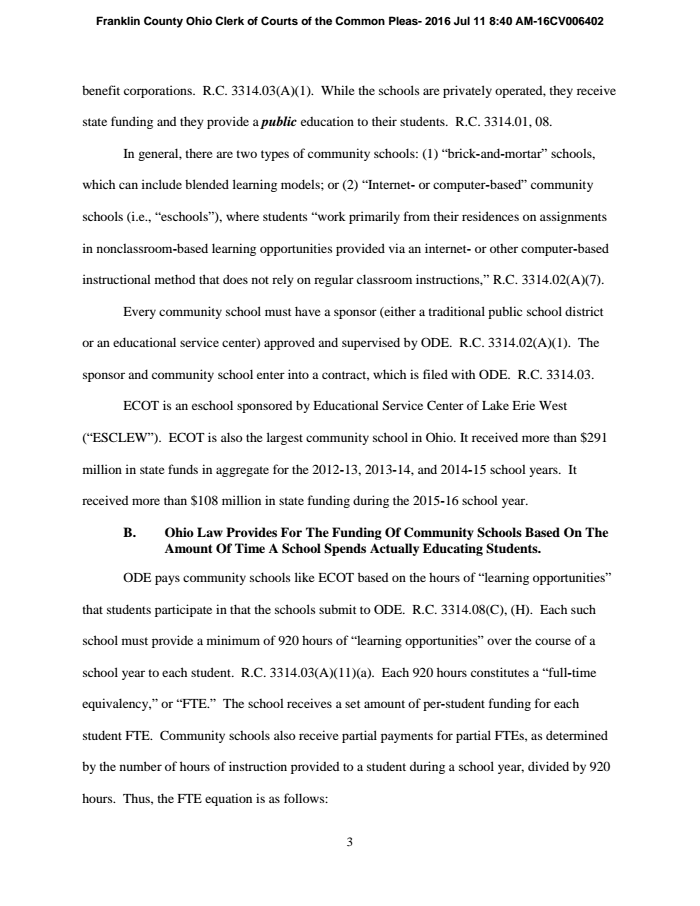SBE News Release for July 13, 2016 - State Board of Education (CA Dept of Education):
Board Sets Balance of State and Local Measures to Hold Schools Accountable
The California State Board of Education today affirmed state and local measures of progress for California’s new school accountability system. In addition to scores on standardized tests in English and math, schools will be held accountable for students’ college and career readiness, proficiency for English learners, graduation rates, chronic absenteeism, suspension rates and school climate, basic conditions at a school, implementation of academic standards, and parent engagement.
The board intends to adopt evaluation rubrics supporting the new accountability system in September 2016 so educators, parents and stakeholders have a clearer picture about how local schools are serving students. A lack of progress for subgroups of students within educational agencies will be highlighted in an equity report and signal the need for support and intervention from county offices of education and the state superintendent of public instruction.
"Improving school accountability is a priority set by the Governor and Legislature under the new school funding formula. In this first year, we have a limited set of options for measuring performance across all of California’s 10,000 school sites. Overall much greater access to information about school performance will be available beginning in 2016-17, although we anticipate improvements to this system over time," explained California State Board of Education president Michael Kirst.
In California's new school funding and accountability system, more students, parents, educators and stakeholders are involved in educational decision-making than ever before. An initial online top level summary display (DOC) presented by the staff highlights the state’s educational priorities, and once finalized it will be available for each school. More detailed reports and resources for improving outcomes for local students also will be available online. In addition, an equity report is included in the display that will purposely highlight any significant lack of progress for specific student subgroups to promote equity. Today's board discussion focused the state’s requirements. The federal government now is working to finalize regulations for its Every Student Succeeds Act, the new federal accountability law. Board members cautioned against recreating "No Child Left Behind tripwires" and spoke in favor of preserving local flexibility.
"California is at the forefront nationally in establishing one coherent school accountability system that supports local, state and federal requirements. Our goal is to establish one system that holds schools accountable for progress, maximizes data to those closest to students and classrooms, and makes access as user-friendly as possible," Kirst said.
The 2016-17 State Budget includes $24 million for the California Collaborative for Educational Excellence (CCEE) to provide training for educators and stakeholders to support the effective use of the evaluation rubrics and local accountability plans. The CCEE will work to facilitate the broad use of data to empower local decision-making processes and ensure that resources are efficiently allocated to improve student outcomes. The law requires that the training will begin after the California State Board of Education adopts the evaluation rubrics and no later than October 16, 2016.
###
The board unanimously approved the following motion.
Staff recommend that the SBE take the following action related to the design of the LCFF evaluation rubrics:
- Approve a measure of college and career readiness, as specified in Attachment 1, including:
- Adopting the College and Career Indicator (CCI), which combines Grade 11 test scores on English Language Arts (ELA) and Math and other measures of college and career readiness, as a state indicator (formerly called “key indicators”)[1];
- Using the CCI to establish standards for Priority 7 (Access to Broad Course of Study) and Priority 8 (Outcomes in a Broad Course of Study) based on the approved methodology of calculating performance for state indicators;
- Modifying the state indicator for student test scores on ELA and Math (Priority 4 – Pupil Achievement), approved at the May 2016 Board meeting, to remove the Grade 11 scores, in order to avoid double-counting those test scores in two state indicators; and
- Directing staff to prepare a recommendation for the September 2016 Board meeting on the final technical specifications for the CCI.
- Approve a methodology for establishing standards, as specified in Attachment 2 for:
- Priority 1 (Appropriately Assigned Teachers, Access to Curriculum-Aligned Instructional Materials, and Safe, Clean and Functional School Facilities),
- Priority 2 (Implementation of State Academic Standards),
- Priority 3 (Parent Engagement),
- County Office of Education (COE) Priority 9 (Coordination of Services for Expelled Students), and
- COE Priority 10 (Coordination of Services for Foster Youth).
- Approve inclusion of a standard for the use of local climate surveys to support a broader assessment of performance on Priority 6 (School Climate), as specified in Attachment 2.
- Approve inclusion of an Equity Report, which identifies instances where any student subgroup is in the two lowest performance categories (currently Red or Orange) on a state indicator, within the top-level summary data display, as specified in Attachment 4.
- Direct staff to develop, in advance of the September 2016 meeting, a proposed timeline through the end of the 2017 calendar year that addresses the further developmental work after approval of the initial phase of the evaluation rubrics, including, but not limited to:
- the state and local indicators,
- standards for the state indicators and/or LCFF priorities,
- the statements of model practices, and
- the alignment of elements included in the ESSA state plan with the LCFF evaluation rubrics.






















